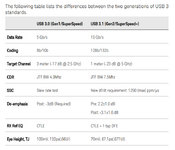engr_joni_ee
Advanced Member level 3
I am looking at the USB 3.1 standard. I understand that CTLE is needed at the receiver but I don't get what is "de-emphasis" in the attachment. Is this pre-emphasis at the Tx with some +ve gain and then post-emphasis which some -ve gain. In other words is that gain or amplification at the Tx before actual transmission and then gain reduction at the receiver which is described as pre (+ve) and post (-ve) emphasis and de-emphasis respectively.
